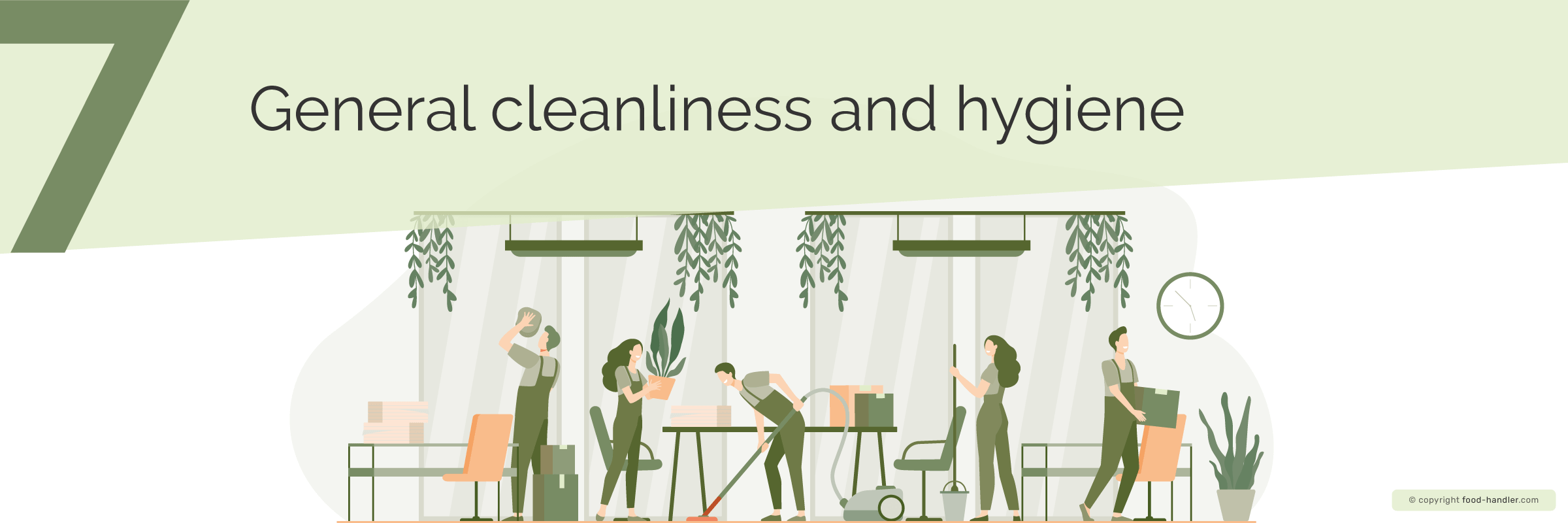FOOD HYGIENE AND SAFETY - LEVEL 2 COMPLIANT - CERTIFICATION


Updated on 2025
Lesson 7: summary

We are talking about the cleanliness of everything that will surround the food, from the utensils to the facilities. Cleaning and disinfecting are not the same, they are two complementary actions. But what is the difference between cleaning and disinfecting?
Cleaning is the removal of all visible residues that can serve as food for microorganisms. Disinfecting eliminates or greatly reduces microorganisms that may be present, and should be performed after cleaning. The correct sanitization is determined by cleaning and disinfection programs, where a written control of all this will be carried out.
In order to maintain a correct sanitization we must take into account that there are PRACTICES that are not permitted in the food sector, and we must know them.
With regards to the handling of waste and residues, different aspects must be taken into account so that this area, which is usually a dirty area, is not a source of pollution that could attract plagues. We must prevent the appearance of plagues and, for this, we must comply with and monitor the preventive measures of the facilities such as nets and mosquito nets, grids, insect collectors…
And, if we find any animals, we must notify external companies, approved by the competent authorities, so that they can make them disappear.
Lesson 7: extended
Correct food hygiene and handling is essential in all catering or food handling premises, so it is essential to follow a correct cleaning and disinfection protocol. We clean because it can be dangerous due to the appearance of microorganisms, but we also do it to avoid the appearance of pests, since areas with bad cleaning favour the appearance of these animals.
All cleaning and disinfection is carried out to eliminate microorganisms and to avoid the appearance of pests.
We have previously advanced the most frequent ones: birds, insects, rodents... and for this reason we, as manipulators, can control that different PREVENTIVE MEASURES are fulfilled so that they do not appear:
But if, despite these measures, we find any animal, we must notify external companies, approved by the competent authorities, so that they can destroy these pests. Under no circumstances will we be able to use products that we "find" to deal with this problem, since special methods and products must be used for each establishment and each animal.
With regard to the management of waste and residues, different aspects must be taken into account so that this area, which, a priori, will always be dirty, even if it is as clean as possible. This area is a major source of pollution that can attract pests, so to avoid risks, all waste bins:
In order to maintain proper hygiene in premises where food is handled, we must take into account hygienic practices for equipment and utensils:
The first thing is to differentiate between cleaning and disinfection. Is it the same? No. They are two different actions that must be taken together, and in this way we will obtain a correct sanitation in everything that surrounds the food.
Cleaning is the removal of all visible residues that may serve as food for microorganisms. If we just clean up we are not going to eliminate the microorganisms, which could grow on those surfaces.
In general, we would try to remove everything we can see, using hot water and detergents (according to the area to be cleaned, as each industry needs a specific type of cleaner). To do this, we will use utensils that will help us to remove this dirt (scourers, brushes, etc....).
Disinfection must be carried out after cleaning, and with it we will be able to eliminate or reduce to a great extent any microorganisms that may exist, up to limits that do not pose a risk of contamination of food.
To disinfect we will use chemicals such as bleach, water vapor with other products.... The steps we would follow for a good cleaning and disinfection would be:
We use 256 bit SSL encryption technology to guarantee the security of our website. You are safe with us.